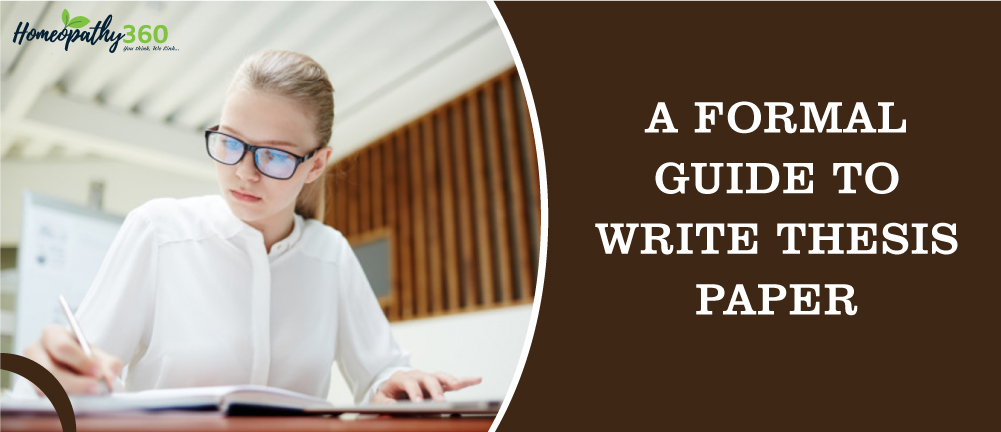
Abstract:
This article is a discussion about the format of the thesis for Homoeopathic P.G. students. Most of the students come to me with the question, “Madam how to write the Dissertation?”
As they are not properly aware about the procedure to write the thesis, it’s my small contribution to give them the format as well as the procedure to write a thesis paper. In my next article I will discuss briefly about bibliography and the different font sizes for a proper thesis.
Key Words:
Dissertation, research, format of research
Abbreviations:
P.G.-post graduation; T.L.C.-Thin lair chromatography; CCRH-Central council of research in homoeopathy; R.C.T-Randomised controlled trial; L.M Potency-fifty millesimal potency.
Introduction:
Research: Application of the scientific method in the study of problems. It is an objective, impartial, empirical, logical analysis and recording of controlled observation that may lead to the development of generalisation, principal or theory, result and control of events. Research may be as replication, repetition and duplication.
To do a research, the first necessary thing is to choose a broad field within which one can conduct the study. Researcher should have an interest in the field of study. To search a new fact, thorough understanding is the priority in selecting problem for the study. The aim of research is to explore the matter in a scientific and “rational” way and the conclusions must be used for the development of skills, clinical practices, store and growth.1
Aim of this study:
To give knowledge about the format of dissertation.
Review of literature:
Over the past decade, documented research has become mandatory to every system of medicine. Homoeopathy is also doing researches and publishing in various journals. Different institutions are researching with homoeopathic medicines; TLC studies are published in journals.
In homoeopathy we are doing research, CCRH makes different experimental studies on different medicines but still there are some areas where we lack or are being criticised. We have to document our science as per the scientific methods. It is the challenge before us. New work needs to be reconstructed at multi-centric levels in large samples will help us to better understand the depth of homoeopathic research.2
Different study done in homoeopathy:
- Case series report:
This typical study is an intensive investigation of a social unit. The analysis of the factors and their inter-relationships, help the researcher to construct a comprehensive picture.3
- Cross section studies:
It is the examination of a cross section of population at one point of time and it helps to generate a hypothesis.4
- Case control study:
It is a study that compares patients who have a disease (cases), with patients who do not have the disease or outcome (controls), and looks back retrospectively to compare that how frequently the exposure to a risk factor is present in each group to determine the relationship between the risk factor and the disease.5
- Cohort Study:
It is forward looking study. It is also known as prospective study. There is a regular follow up over a period of time. The study proceeds from cause to effect.6
- Randomized
Controlled Trials (RCT):
This is a type of experimental study.
Format of a research:
1.0. Title page
1.1. Certificate by the guide
1.2. Declaration
1.3. Acknowledgments:
It is a part of thesis to give the gratitude to those persons who help you in your research.6
1.4. Abstract:
- Abstract: It tells us about the importance of my paper. It also gives a summary of a research with result. Abstract should be short, precise.7
- Readable and meaningful.
- No repeated information
1.5. Table of contents:
- All headings and subheadings with page numbers
- Indent subheadings
- It will look something like this:
| Sr. No. | content | Page |
| 1. | Introduction | xxx |
1.6. List of tables
1.7. List of charts
1.8. List of abbreviations
1.9. List of appendices
2.0. Introduction:
An interesting introduction can make a person curious to read the rest. It should be authentic, scientific. Mention the previous work in this area, along with the most recent work. An explanation of your work’s necessity should be discussed.
It is better to write the introduction part latter because you can arrange it properly only then.8
3.0. Objective:
Objectives will be in 4-5 sentences, clearly defining the objects of study.
4.0. Review of literature:
Re-view, means the previous works done on the topic. For exp: ‘utility of L.M. potency in homoeopathy’, it is the topic. We have to write the review surveys from different books, articles, and any other sources relevant to this particular issue, any area of research, or theory on this L.M. potency. 9
5.0. Materials and method:
- Information regarding the believability of your results.
- Information for another researcher to replicate your experiment.
- Description of materials, procedure, theory.
- Calculations, technique, procedure, equipment.
- Discussion of Limitations, assumptions, and range of validity.
- Description of analytical methods, including reference.10
6.0. Observation and result:
In this section the investigator informs the observation and findings of this study
7.0. Discussion:
Discussion contains the summarization of the result. It includes-the pattern, exception, cause, present result of observation, Hypothesis, line of reasoning, significance of the result.11
8.0. Summary:
9.0. Conclusions:
After doing your research and proper investigation, interpret your judgment. Try to not repeat the same words again and again.12
10.0. Bibliography (References):
Write the books name from where you have taken the references. There is a certain pattern to write the bibliography. It will be discussed in my next article.
All reference of the text should be listed here.13
11.0. Appendices:
It will contain raw data, figure, table and other information; it will give documentation to the controversial argument of your data.
Note: Please attach the case record format, case records Score chart, Master chart and consent form in your dissertation. 14
Expostulation:
After a brief discussion I want to say that we must encourage our pathy for new and new research of medicines, reproving medicines with few symptoms, to find the explanation of our preparation procedure. 15 Once, in a reputed seminar, a respected pupil discussed that homoeopaths do a smaller number of researches. He also told that one may present a case of headache, may relief the symptoms by Belladonna or Natrum muriaticum but there is no research. He also told that the case looks fake. May be the presenter serves his case with the case history format, but who will belief him? Research study will belief you. Documentation will belief you.
Homoeopathy has a perfect and particular law. If we follow the fundamental principles of homoeopathy by Dr Hahnemann, then we are practicing the evidence-based homoeopathy.16 To make this system more fruitful and more scientific acceptance, we need to have research studies and internationally accepted standards. Also, we can research to know the long-term effects of homoeopathy in preventing the chronic disease conditions. Except this, we need to concentrate on homoeopathic development, quality education, and homoeopathic pathogenic trials – drug proving, writing in peer-review homoeopathic journals.17
Our master took the initiative stage, we the followers will make it perfect.
Conclusion: Research can make us more perfect. To make homoeopathy best, oe must concentrate to more and more research works.
References
- Abdulaziz A, Rao U
- Advanced Educational Statistics, First edition, Publisher: Himalaya Publishing House, Publication Date: 2011,page no:112-120
- Cresswell JW,Educational research: planning, conducting and evaluating quantitative and qualitative research; fourth Edition, Publisher: Pearson Education ,page no:28-29
- Mishra SB, Alok S,Hand book of research methodology, a compendium for scholars and researchers; EDUCREATION PUBLISHING RZ 94, Sector – 6, Dwarka, New Delhi – 110075 ShubhamVihar, Mangla, Bilaspur, Chhattisgarh – 495001, Page:92-110
- Koul L ,Methodology of educational Research ,Third Revised Edition, ,Vikas Publishing House Pvt Ltd,A-22,Sector-4,Noida-201301, Page:109-186,416-429
- Kothari CR; Garg G ,Research methodology : methods and techniques ,2nd revised edition,,2004, Publisher: NEW AGE INTERNATIONAL (P) LIMITED, PUBLISHERS 4835/24, Ansari Road, Daryaganj, New Delhi – 110002 ,Page no:234
- Agrawal R, BVLN Rao; Research Methods :concepts, process and practice,first edition 2013 ,Published by Shipra Publications, LG 18-19, Pankaj Central Msrket, IP Ext., Patparganj, New Delhi, Delhi 110092,page no:116
- Kumar R, Research Methodology: A Step-by-Step Guide for Beginners ,4th Edition,SAGE Publication,New Delhi, B 1/11 Mohan Cooperative Industrial Area, Mathura Road.page no:179
- Merriam HB, Tisdell EJ, Qualitative Research: A Guide to Design and Implementation 4th edition Publisher: San Francisco, CA : John Wiley & Sons, 2016.
- Booth WC, Colomb GG, and Williams JM, The Craft of Research Third edition (April 15, 2008) , Publisher: University Of Chicago Press 1027 E, 57th Street, Chicago, Illinois, United States of America.; page no:110
- Lune H and Berg BL, Qualitative Research Methods for the Social Sciences , Ninth Edition , ,published in 2017, Publisher: Pearson Education Limited Edinburgh Gate Harlow Essex CM20 2JE England, page no:188
- Durdella NR, Dissertation Methodology: A Guide for Research Design and Methods, 1st Edition , SAGE Publications, B 1/11 Mohan Cooperative Industrial Area, Mathura Road, Page no: 85
- Nagar G, Mehta R, Saraswat K; Effectiveness of combined approach of giving Homoeopathic constitutional remedies along with Ferrum Metallcum 6x in management of cases of Menorrhagia –a case series; The Homoeopathic Heritage, , Published by: Wolters Kluwer,61-65,Institutional area, Janakpuri, New Delhi- 110058, , No.10,Jun2020, Vol:45 Page-12-16
- Kadir K et al; The effects of Tocotrienol –Rich Vitamin E on diabetic neuropathy, A phase ii Randomized controlled trial; Inventi Impact, Clinical Research, Oct-Dec-2020 ,Issue:4, Page:234-238
- Manchanda RK et al; Calendula mother tincture vs normal saline for ulcer dressing as an add on to Individualized homoeopathic intervention in the management of diabetic foot ulcer-A randomized controlled pilot study; Indian Journal Of Research In Homoeopathy, , Anil Khurana, Central Council For Research in Homoeopathy, Institutional Area, Janakpuri, New Delhi, India, ,Issue-4,Oct-Dec 2020, Vol-14,Page no:233-239
- Piet H. van der Graaf, Clinical Pharmacology and therapeutics[internet], American society for Clinical Pharmacology and therapeutics ,oct-2021, Available from https://ascpt.onlinelibrary.wiley.com/journal/15326535
- Pierrat V , Neurodevelopmental outcomes at age 5 among children born preterm:EPIPAGE-2 cohort study [internet], The BMJ,BMA House, Tavistock Square, London,UK, April28 -2021 ,Available from http://www.bmj.com/content/321/7259/504,published:19th
- WHO recommended format for a research protocol, WHO Headquarters in Geneva
Avenue Appia 20, Geneva Switzerland, Available from http://www.who.int/rpc/research_ethics/format_rp/en/index.html
About the author
Dr Monimala Pramanick (Sen)
Lecturer in Homoeopathy Pharmacy Dept.
Noble Homoeopathic College & Research Institute, Junagadh





